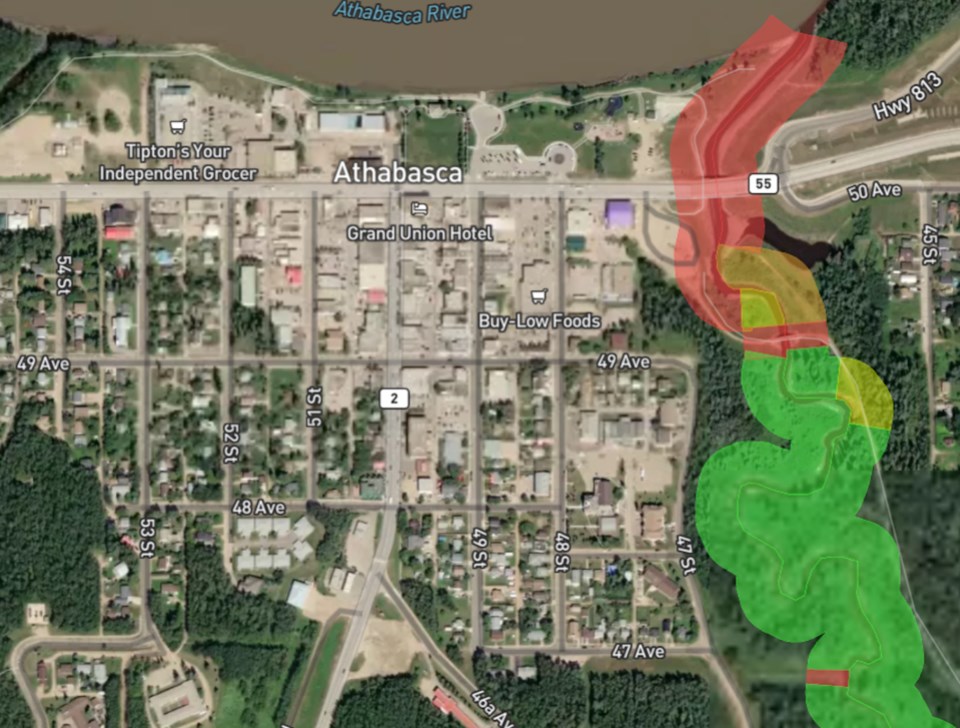ATHABASCA — The Athabascsa Watershed Council (AWC) was the second water-based delegation to dip into town council, with a presentation touching on the organizations previous work along the Tawatinaw River, and a proposal for a new multi-year shoreline restoration project.
During the Sept. 19 Town of Athabasca council meeting, watershed science coordinator Sarah MacDonald and project coordinator Katie Seifert held council’s attention as they highlighted areas of the Tawatinaw River banks in need of restoration and outlined the project plan.
Councillors voted unanimously to accept the report as information and to send a letter of support to the AWC recognizing the ongoing shoreline habitat project.
“The Tawatinaw River is pretty good here,” said MacDonald, referencing a colour-coded aerial view of the river as it flows through town. A majority of the shoreline showed green — meaning intact — but MacDonald pointed out red, yellow, and orange areas close to Highway 2, “that aren’t as intact, may not be as healthy, and (are) something we might want to look further into.”
Intact shorelines are banks with native vegetation to stabilize the soil, and minimal infrastructure and human activity. According the 2022 Tawatinaw River Watershed Riparian Area Assessment report available on the AWC website, 154 kilometres, or 68 per cent of the shoreline is classified as highly intact, 13 per cent is moderately intact, and six and 13 per cent are low and very low, respectively.
MacDonald said an assessment of the Tawatinaw where it meets the Athabasca River earlier this summer identified invasive weeds and areas where banks would benefit from stabilization, a project the organization hopes to spearhead.
“Planting trees, putting some signage up … taking those invasive species away and then putting a fence (along the pathway) to help that riparian area grow back,” would alleviate maintenance costs and man-hours for the town, and allow increased water flow to be absorbed and stored rather than flooding the area, MacDonald said.
The estimated cost of the project hovers around $2,000, $1,500 of which MacDonald said would go towards buying plants and vegetation, and the remainder will go towards materials for the fence, with volunteer labour donated in-kind. Project funding comes from the provincial Watershed Resiliency and Restoration grant program.
MacDonald said the work could start in spring of 2024, and will also include educational signage to inform locals of the project, which will be monitored for five years following the installations.
Coun. Jonathan LeMessurier expressed interest in working with AWC to assess and potentially amend areas of Muskeg Creek, and CAO Rachel Ramey told MacDonald the town would be reaching out shortly to discuss other potential projects.
AWC has been involved in restoring shorelines in the Pembina and Athabasca watersheds and along the Tawatinaw River under the Healthy Shorelines Initiative since 2019. The organization covers an area stretching from Jasper National Park to Wood Buffalo National Park, which MacDonald said accounts for around 24 per cent of the province.
MacDonald said council’s letter of support for the project and previous work is “big for (the) organization” and the Tawatinaw Watershed working group established last November. She noted the river was redirected from it’s natural meandering path around 10 years ago, and said reintroducing the natural biodiversity to the river is a major objective of the combined restoration efforts.
“There used to be Artic grayling in the Tawatinaw River, and that’s one of the goals of the group, to eventually one day we can bring Artic grayling back to the Tawatinaw River and its watershed.”



